
Alessandro di Mariano di Vanni Filipepi, better known as Sandro Botticelli or simply Botticelli, was an Italian painter of the Early Renaissance. Botticelli's posthumous reputation suffered until the late 19th century, when he was rediscovered by the Pre-Raphaelites who stimulated a reappraisal of his work. Since then, his paintings have been seen to represent the linear grace of late Italian Gothic and some Early Renaissance painting, even though they date from the latter half of the Italian Renaissance period.

Carlo Crivelli was an Italian Renaissance painter of conservative Late Gothic decorative sensibility, who spent his early years in the Veneto, where he absorbed influences from the Vivarini, Squarcione, and Mantegna. He left the Veneto by 1458 and spent most of the remainder of his career in the March of Ancona, where he developed a distinctive personal style that contrasts with that of his Venetian contemporary Giovanni Bellini.

Salvator Mundi, Latin for Saviour of the World, is a subject in iconography depicting Christ with his right hand raised in blessing and his left hand holding an orb, known as a globus cruciger. The latter symbolizes the Earth, and the whole composition has strong eschatological undertones.
The School of Ferrara was a group of painters which flourished in the Duchy of Ferrara during the Renaissance. Ferrara was ruled by the Este family, well known for its patronage of the arts. Patronage was extended with the ascent of Ercole d'Este I in 1470, and the family continued in power till Alfonso II, Ercole's great-grandson, died without an heir in 1597. The duchy was then occupied in succession by Papal and Austrian forces. The school evolved styles of painting that appeared to blend influences from Mantua, Venice, Lombardy, Bologna, and Florence.

The Pinacoteca di Brera is the main public gallery for paintings in Milan, Italy. It contains one of the foremost collections of Italian paintings from the 13th to the 20th century, an outgrowth of the cultural program of the Brera Academy, which shares the site in the Palazzo Brera.

The Disrobing of Christ or El Expolio is a painting by El Greco begun in the summer of 1577 and completed in the spring of 1579 for the High Altar of the sacristy of the Cathedral of Toledo, where it still normally hangs. In late 2013 it was on temporary display at the Prado in Madrid, following a period of cleaning and conservation work there; it was returned to Toledo in 2014. It is one of El Greco's most famous works. A document dated July 2, 1577 which refers to this painting is the earliest record of El Greco's presence in Spain. The commission for the painting was secured thanks to El Greco's friendship from Rome with Luis, the son of Diego de Castilla, the dean of the Cathedral of Toledo. De Castilla senior also arranged El Greco's other major commission, on which he worked simultaneously, the paintings for the Toledan church of Santo Domingo el Antiguo.
The decade of the 1490s in art involved some significant events.
The decade of the 1480s in art involved some significant events.

The Life of the Virgin, showing narrative scenes from the life of Mary, the mother of Jesus, is a common subject for pictorial cycles in Christian art, often complementing, or forming part of, a cycle on the Life of Christ. In both cases the number of scenes shown varies greatly with the space available. Works may be in any medium: frescoed church walls and series of old master prints have many of the fullest cycles, but panel painting, stained glass, illuminated manuscripts, tapestries, stone sculptures and ivory carvings have many examples.
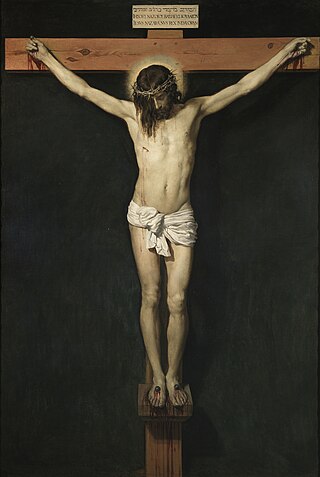
Christ Crucified is a 1632 painting by Diego Velázquez depicting the Crucifixion of Jesus. The work, painted in oil on canvas, measures 249 × 170 cm and is owned by the Museo del Prado.
Vincenzo Pagani was an Italian painter of the Renaissance period.

The Pinacoteca del Castello Sforzesco is an art gallery in the museum complex of the Castello Sforzesco in Milan, northern Italy.
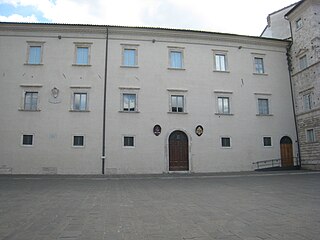
The Diocesan Museum in the Italian town of Ascoli Piceno is located in one wing of the ecclesiastical palazzo, which also contains the city's pinacoteca and the state archeological museum.
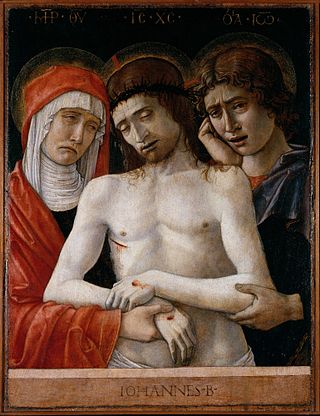
The Pietà or Christ's Body Supported by the Virgin Mary and St John the Evangelist is a tempera-on-panel painting by the Italian Renaissance artist Giovanni Bellini, now in the Accademia Carrara in Bergamo. Dated to around 1455, it is one of his earliest independent works and the prototype for his series of pietàs. It draws on Byzantine icons of the 'imago pietatis', of which there were many examples throughout Venice, and of 'Ritratti di Passione' or 'portraits of the Passion', in which the dead Christ invites the viewer to contemplate his wounds. The crossed arms are drawn from a famous Roman mosaic-icon from Santa Croce in Gerusalemme basilica which was held to be miraculous and had according to legend been commissioned by pope Gregory the Great based on a vision during a mass.
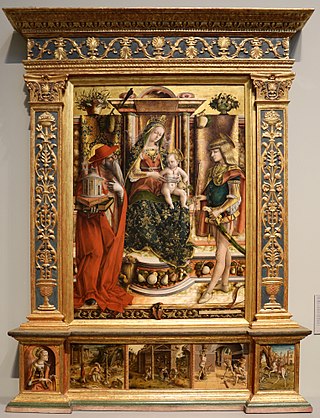
Madonna of the Swallow is a painting by Carlo Crivelli. It is named after the swallow perched on the top left hand corner of the Madonna's throne - the bird was a symbol of the Resurrection. It was commissioned by Ranuzio Ottoni and Giorgio di Giacomo for the church of San Francesco in Matelica in March 1490 - Ottoni was Lord of Matelica and Giacomo was guardian of the local Franciscan monastery. It was completed between 1490 and 1492. It is now in the National Gallery, London, who bought it in 1862.

Madonna and Child with Saints and Donor is a c. 1490 oil on panel painting by Carlo Crivelli. It shows the Madonna and child between Francis of Assisi and Bernardino of Siena, with a tiny figure of the painting's donor kneeling on the balustrade in front of the Madonna. It is stored at the Walters Art Museum in Baltimore.
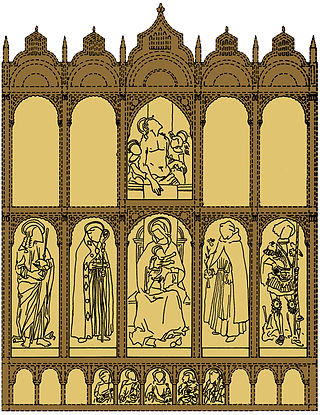
The 1472 Altarpiece was a tempera and oil on panel altarpiece by the Italian Renaissance painter Carlo Crivelli, dated 1472 on the central panel. Also known as the Fesch Altarpiece or the Eckinson Altarpiece, it is now divided up between a number of galleries in the United States and Europe.

Adoration of the Shepherds is a c. 1480 tempera and gold on panel painting by the Italian painter Carlo Crivelli. It is now in the Museum of Fine Arts in Strasbourg, for which it was acquired in Florence by Wilhelm von Bode. Its inventory number is 171. Art historians are uncertain about the dating of the painting, and propositions have ranged from 1470 to 1491.
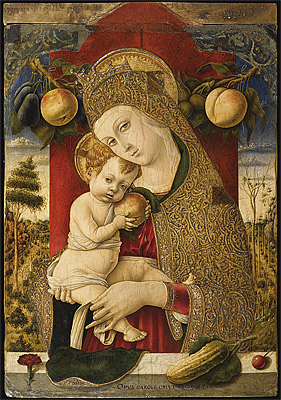
The Lochis Madonna is a tempera and gold on panel painting by Carlo Crivelli, executed c. 1475, and signed OPVS CAROLI CRIVELLI VENETI. It is now in the Accademia Carrara, in Bergamo, which it entered in 1866 from Guglielmo Lochis' collection - its previous history is unknown.
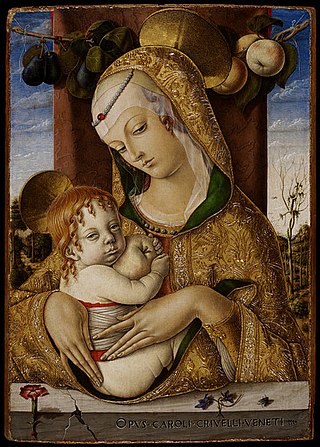
Madonna and Child with an Apple or Madonna and Child Holding an Apple is a tempera and gold on panel painting by Carlo Crivelli, executed c. 1480, now in the Victoria and Albert Museum in London, having entered it as part of the Jones collection - its previous provenance is unknown. It is signed OPVS CAROLI CRIVELLI VENETI.
















